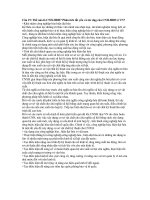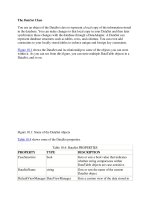Tài liệu The United Kingdom pptx
Bạn đang xem bản rút gọn của tài liệu. Xem và tải ngay bản đầy đủ của tài liệu tại đây (744.79 KB, 218 trang )
This PDF document was made available
from www.rand.org as a public service of
the RAND Corporation.
6
Jump down to document
Visit RAND at www.rand.org
Explore RAND Europe
View document details
This document and trademark(s) contained herein are protected by law
as indicated in a notice appearing later in this work. This electronic
representation of RAND intellectual property is provided for non-
commercial use only. Permission is required from RAND to reproduce, or
reuse in another form, any of our research documents.
Limited Electronic Distribution Rights
For More Information
CHILD POLICY
CIVIL JUSTICE
EDUCATION
ENERGY AND ENVIRONMENT
HEALTH AND HEALTH CARE
INTERNATIONAL AFFAIRS
NATIONAL SECURITY
POPULATION AND AGING
PUBLIC SAFETY
SCIENCE AND TECHNOLOGY
SUBSTANCE ABUSE
TERRORISM AND
HOMELAND SECURITY
TRANSPORTATION AND
INFRASTRUCTURE
The RAND Corporation is a nonprofit
research organization providing
objective analysis and effective
solutions that address the challenges
facing the public and private sectors
around the world.
Purchase this document
Browse Books & Publications
Make a charitable contribution
Support RAND
This product is part of the RAND Corporation monograph series.
RAND monographs present major research findings that address the
challenges facing the public and private sectors. All RAND mono-
graphs undergo rigorous peer review to ensure high standards for
research quality and objectivity.
Prepared for the United Kingdom‘s Ministry of Defence
Approved for public release; distribution unlimited
The United Kingdom’s
Naval Shipbuilding
Industrial Base
The Next Fifteen Years
Mark V. Arena
Hans Pung
Cynthia R. Cook
Jefferson P. Marquis
Jessie Riposo
Gordon T. Lee
The RAND Corporation is a nonprofit research organization providing
objective analysis and effective solutions that address the challenges
facing the public and private sectors around the world. RAND’s
publications do not necessarily reflect the opinions of its research clients
and sponsors.
R
®
is a registered trademark.
© Copyright 2005 RAND Corporation
All rights reserved. No part of this book may be reproduced in any
form by any electronic or mechanical means (including photocopying,
recording, or information storage and retrieval) without permission in
writing from RAND.
Published 2005 by the RAND Corporation
1776 Main Street, P.O. Box 2138, Santa Monica, CA 90407-2138
1200 South Hayes Street, Arlington, VA 22202-5050
201 North Craig Street, Suite 202, Pittsburgh, PA 15213-1516
RAND URL: />To order RAND documents or to obtain additional information, contact
Distribution Services: Telephone: (310) 451-7002;
Fax: (310) 451-6915; Email:
Cover design by Barbara Angell Caslon
Cover photo from Reuters, via Landov LLC
The research described in this report was sponsored by the United King-
dom’s Ministry of Defence. The research was conducted jointly in RAND
Europe and the RAND National Security Research Division.
Library of Congress Cataloging-in-Publication Data
The United Kingdom’s naval shipbuilding industrial base : the next fifteen years
/ Mark V. Arena [et al.].
p. cm.
“MG-294.”
Includes bibliographical references.
ISBN 0-8330-3706-4 (pbk. : alk. paper)
1. Shipbuilding industry—Great Britain. 2. Warships—Great Britain—Design and
construction. 3. Great Britain. Ministry of Defence—Procurement. 4. Great Britain.
Royal Navy—Procurement. I. Arena, Mark V.
VM299.7.G7U55 2005
338.4'7623825'0941—dc22
2005001980
iii
Preface
In the autumn of 2003, the United Kingdom’s Ministry of Defence
(MOD) engaged the RAND Corporation to study the domestic
capacity for naval ship construction. The impetus for the study was a
concern on the MOD’s part that the confluence of several ship-
building programmes (i.e., Astute, MARS, CVF, FSC, JCTS, and
Type 45
1
) could potentially overburden the industry. The objective
of the study was to take a strategic look at the shipbuilding industry
over the next 15 years to determine where there might be capacity
limitations and to offer recommendations as to how any identified
limitations might be addressed. For example, are there production
skills or trades that will be in short supply? If so, what policy options
are open to the government to remedy such a shortfall (training
incentives, shifting of work, etc.)? The scope of the study was limited
to the UK industry, in line with current defence procurement policy.
This report is the final product of that study and summarises the
analysis.
We organised our analysis by decomposing capacity into three
major elements: labour, facilities, and suppliers. Labour encompassed
all aspects of ship production (manufacture, design, engineering,
management, outfitting, and support). The facilities analysis ad-
dressed the throughput limitations of the major shipyard assets, such
as piers, docks, and slipways. For simplicity, we limited this examina-
tion to facilities involved in final assembly and afloat outfitting. The
____________
1
For a full listing and description of these ships, see Table S.1 in the Summary.
iv The United Kingdom’s Naval Shipbuilding Industrial Base: The Next 15 Years
suppliers make up a major portion of the shipbuilding value chain
and provide a wide range of different products and services—from
painting services to complex weapon systems. The suppliers’ ability to
meet any peak in demand will affect the ability of the MOD to
procure ships within the desired time frame and budget.
For our capacity evaluations, we relied on data surveys and
interviews with many firms and organisations associated with ship-
building in the United Kingdom, including shipbuilders, ship repair-
ers, suppliers, industry associations, and government organisations.
This interaction took the better part of five months.
This report should be of special interest not only to the MOD’s
Defence Procurement Agency (DPA) but also to service and defence
agency managers and policymakers involved in weapon system acqui-
sitions on both sides of the Atlantic. It should also be of interest to
shipbuilding industrial executives in the United Kingdom.
This research was sponsored by the MOD and conducted
within RAND Europe and the International Security and Defense
Policy Center of the RAND National Security Research Division,
which conducts research for the US Department of Defense, allied
foreign governments, the intelligence community, and foundations.
For more information on RAND Europe, contact the president,
Martin van der Mandele. He can be reached by email at mandele@
rand.org; by phone at +31 71 524 5151; or by mail at RAND
Europe, Netonweg 1, 2333 CP Leiden, The Netherlands. For more
information on the International Security and Defense Policy Center,
contact the director, Jim Dobbins. He can be reached by email at
; by phone at (310) 393-0411, extension
5134; or by mail at RAND Corporation, 1200 South Hayes Street,
Arlington, VA 22202-5050 USA. More information about RAND is
available at www.rand.org.
v
Contents
Preface iii
Figures
xi
Tables
xv
Summary
xvii
Acknowledgements
xxxv
Abbreviations
xxxvii
CHAPTER ONE
Introduction 1
Warship Production Is a Unique Industry
2
MOD Ship Programmes
5
Programmes Past Main Gate
6
Projects Pre–Main Gate
7
Other Speculative Programmes
9
Notional Programme Timelines
10
Business Environment of UK Naval Shipbuilding Industrial Base
Since 1985
12
Issues for Policymakers
16
Study Structure
17
Plan
18
Labour
19
Facilities
19
Suppliers
19
Survey of the UK Shipbuilding Industry
20
Study Outline
21
vi The United Kingdom’s Naval Shipbuilding Industrial Base: The Next 15 Years
CHAPTER TWO
Labour Demand 23
Methodology
24
Basic Assumptions
27
Additional Assumptions
31
Current MOD Plan: Overall Labour Demand
33
Current MOD Plan: Demand for Specific Labour Skills
35
Management Labour Skills
35
Technical Labour Skills
36
Structural Labour Skills
37
Outfitting Labour Skills
38
Support Labour Skills
39
Macro Versus Micro View of Demand
39
Alternate Future Scenarios
41
Scenario 1: Decreased MOD Requirements or Budgets
42
Scenario 2: Addition of Future Submarine to the MOD’s
Requirements
44
Scenario 3: Increased MOD Future Requirements
47
Future MOD Programme Challenges
50
Options for Managing Increased MOD Demand
51
Illustrative Results of Level-Loading Future MOD
Labour Demand
55
Other Build Strategies
58
Summary
59
CHAPTER THREE
The Supply of Naval Shipyard Labour in the United Kingdom 61
Employment Status of the UK Shipbuilding and Repair
Industrial Base
62
Regional Differences in UK Shipyard-Related Employment
62
Sector Employment in the UK Shipbuilding and Repair Industry
63
UK Shipbuilding and Repair Industry Workers Are Ageing
66
Small Reliance on Temporary Workers
67
Ability of the Naval Shipyards to Expand Their Workforces
68
Concerns About Labour Shortages
68
Contents vii
Recruitment in the Shipbuilding and Repair Industry Faces Significant
Obstacles
69
Shipyard Training Initiatives
70
Consequences of Unemployment, Demographic Changes, and Shipyard
Redundancies
71
Recent Shipyard Recruiting Efforts
73
Pools of Labour That Could Be Tapped
75
Shipyards Rely on Outsourcing to Varying Degrees
76
A Comparison of the Supply of Naval Workers with the Demand Under
Different Future Scenarios
77
Three Supply Cases
78
Shipyard Labour Supply Model
80
Results of the Shipyard Supply Analysis
81
Concluding Observations
86
CHAPTER FOUR
Facilities Utilisation at the UK Shipyards 89
Ship Production Facilities and Phases
89
How We Studied Facilities and Phases
91
Identifying Demand and Assigning Facilities to Phases
92
Final Assembly Facilities’ Capacity and Considerations
93
Afloat Outfitting Facilities Capacity Considerations
96
Capacity Implications for Future Programmes
100
Type 45
101
CVF
106
MARS
107
Astute
108
LSD(A)
109
Future Surface Combatant
109
Joint Casualty Treatment Ship
110
Summary
110
CHAPTER FIVE
The UK Shipbuilding Supplier Industrial Base 113
Research Approach
113
Characterising the Supplier Base—The Shipyard Perspective
115
viii The United Kingdom’s Naval Shipbuilding Industrial Base: The Next 15 Years
What They Supply 115
Where They Are
117
Three Measures of Supplier Strength
118
Summary
122
Supplier Survey Results
122
Demographic Information on Sample Suppliers
123
Suppliers’ Business Base
124
Number of Customers
127
Number of Competitors
128
Recruiting Challenges
129
Engineers Presented the Most Challenges for Recruiting
129
Challenges Working for the MOD
130
Summary
132
Results from Linking Shipyard and Supplier Surveys
132
Developing an Effective Supplier Strategy
133
Conclusion
134
CHAPTER SIX
Nontraditional Sources for Naval Shipbuilding:
Commercial Shipbuilding and Offshore Industries
137
Declining Markets for Offshore and Commercial Work
138
Potential Resources Available
140
Labour
141
Facilities
143
Strengths and Weaknesses of Using Offshore Firms in Naval
Production
143
Summary
146
CHAPTER SEVEN
Issues for the Ministry of Defence to Consider 147
Summary
147
Labour Demand
147
Labour Supply
149
Facilities
150
Suppliers
151
Potential Remedial Actions That MOD Can Take
151
Contents ix
The MOD Needs to Make Long-Term Industrial Planning Part of
the Acquisition Process
154
Define the Appropriate Role of the Offshore Industry
156
Carefully Consider the Implications of Foreign Procurement of
Complete Ships
157
Labour Wage Pressures During Peak Demand
158
Encourage Long-Term Investment Through Multi-Ship Contracts
159
Consider the Feasibility of Competition in Light of the Industrial Base
Constraints
159
Explore the Advantages of Common Design Tools
160
Conclusions
160
APPENDIX
A. Effects of Schedule Slippage on MOD Labour Demands 163
B. Ship Dimensions
171
C. Skill Breakout, by Management/Technical and Manufacturing
Categories
173
References
175
xi
Figures
S.1. Schedule of MOD Naval Programmes, 2005–2020 xx
S.2. Future MOD Labour Demands, by Programme
xxiv
S.3. Direct Labour Demands for the Current Plan and a Level-Loaded
Example
xxv
S.4. Projected Shipyard Labour Supply Without Additional
Recruitment, 2004–2020
xxvi
S.5. Shipyard Employment Projections Versus Demand
xxviii
S.6. Total UK Final Assembly and Afloat Outfitting Facility
Requirements, 2004–2020
xxix
1.1. Gantt Chart of MOD Naval Programmes over the Next
15 Years
10
1.2. Royal Navy Fleet Size over the Past Four Decades
12
1.3. Number of Combatants Delivered Each Year
13
1.4. History of Naval Shipbuilders Post-Privatisation
15
1.5. Study Hierarchy
18
2.1. RAND’s Basic Labour Forecasting Model
24
2.2. Example of Direct Labour Distribution Curves for an Individual
Ship Class
27
2.3. Individual Ship Aggregation to Represent Entire Shipbuilding
Programme
28
2.4. Future MOD Labour Demand, by Programme
33
2.5. Future MOD Labour Demand for Management Skills,
2004–2025
35
xii The United Kingdom’s Naval Shipbuilding Industrial Base: The Next 15 Years
2.6. Future MOD Labour Demands for Technical Skills,
2004–2025
36
2.7. Future MOD Labour Demand for Structural Skills,
2004–2025
37
2.8. Future MOD Labour Demand for Outfitting Skills,
2004–2025
38
2.9. Future MOD Labour Demand for Support Skills,
2004–2025
39
2.10. Scenario 1: Decreased MOD Requirements or Budgets—
Labour Projections by Programme, 2004–2025
43
2.11. Scenario 1: Decreased MOD Requirements or Budgets—
Labour Projections by Skill Trade, 2004–2025
44
2.12. Scenario 2: Addition of Future Submarine—
Labour Projections by Programme, 2004–2025
46
2.13. Scenario 2: Addition of Future Submarine—
Labour Projections by Skill Trade, 2004–2025
47
2.14. Scenario 3: Increased MOD Future Requirements—
Labour Projections by Programme, 2004–2025
49
2.15. Scenario 3: Increased MOD Future Requirements—
Labour Projections by Skill Level, 2004–2025
49
2.16. Level-Loading by Extending the Time Between Ship-Builds
52
2.17. Impact of Moving Programmes to Avoid Peak Demand
53
2.18. Impact of Both Extending and Moving Programmes to Avoid
Peak Demand
54
2.19. Level-Loading Labour Projections, by Programme
56
2.20. Base Case and Level-Loaded Demands Compared with Current
MOD Demand
56
2.21. Level-Loading Labour Projections, by Skill Level
57
3.1. UK Shipbuilding, Repair, and Offshore Employment in
the 1990s
63
3.2. Regional Shipbuilding, Repair, and Offshore Employment in
the 1990s
64
3.3. Share of Workers in Shipbuilding and Repair Subsectors
in 2000
65
3.4. Number of Workers in the Naval Yards, 1999–2003
65
3.5. Age Profile of the Workforce in the Naval Shipyards in 2003
67
Figures xiii
3.6. Unemployment Levels in Important Shipyard Towns
in 2002
72
3.7. Number of Recruits in the Naval Shipyards, 1999–2003
74
3.8. Total and Peak Outsourcing Undertaken by UK Naval
Shipbuilding and Repair Companies
77
3.9. Shipyard Labour Supply Model
80
3.10. A Comparison of the Shipyard Labour Supply and Demand,
2004–2020
81
3.11. Projected Shipyard Labour Supply by Skill Category Without
Additional Recruitment, 2004–2020
82
3.12. Forecast of the Naval Shipyard Management and Technical
Workforce: Minimised Recruitment
83
3.13. Forecast of the Naval Shipyard Manufacturing Workforce:
Minimised Recruitment
84
3.14. Forecast of the Shipbuilding Manufacturing Workforce:
8 Percent Recruitment Rate
85
4.1. Ship Production Timeline
90
4.2. Distribution of Final Assembly Facility Lengths
93
4.3. Distribution of Final Assembly Facility Beams
95
4.4. Distribution of Final Assembly Facility Draughts
95
4.5. Distribution of Afloat Outfitting Facility Lengths
97
4.6. Distribution of Afloat Outfitting Facility Beams
98
4.7. Distribution of Afloat Outfitting Facility Draughts
99
4.8. Type 45 Work Allocation
101
4.9. Final Assembly Facilities Requirements for Type 45 Programme:
VT Shipbuilding
103
4.10. Final Assembly Facilities Requirements for Type 45 Programme:
BAE Systems
104
4.11. Afloat Outfitting Facilities Requirements for Type 45 Programme:
BAE Systems
105
4.12. Final Assembly and Afloat Outfitting Facilities Requirements for
MOD Ships, 2004–2020
111
5.1. Industrial Sectors of the Identified Suppliers
116
5.2. Locations of Suppliers, by Country
117
5.3. Suppliers’ Ability to Take on More Work
119
5.4. Long-Term Stability and Viability of Suppliers
120
xiv The United Kingdom’s Naval Shipbuilding Industrial Base: The Next 15 Years
5.5. Dependence on Supplier/Competition 121
5.6. Size of Suppliers, by Number of Employees in 2003
123
5.7. Average Supplier Dependence on Different Sectors
125
5.8. Percentage of Suppliers’ Revenue Derived from MOD Ship
Programmes
126
5.9. Percentage of Suppliers’ Revenue Derived from All Ship and
Offshore Work
126
5.10. Percentage of Suppliers’ Revenue Derived from Military
Work
127
5.11. Numbers of Marine and Non-Marine Customers
128
5.12. Numbers of Marine and Non-Marine Competitors
129
5.13. Ease of Recruiting Four Classes of Employees
130
6.1. Decline of Commercial Shipbuilding in the United Kingdom
Over the Past Two Decades
139
6.2. UK Offshore New-Build Market
139
A.1. Schedule-Slip Scenario Labour Projections by Programme
166
A.2. Schedule-Slip Scenario Labour Projections by Skill Level
168
A.3. Base Case, Level-Loaded, and Schedule Slip Demands Compared
to Current MOD Demand
169
xv
Tables
S.1. Future MOD Ship Programmes xix
1.1. Average Age and Full Ship Displacement of the Fleet
11
2.1. Current MOD Shipbuilding Programmes
29
2.2. Projected MOD Shipbuilding Programmes
29
2.3. Scenario 1: Decreased MOD Requirements or Budgets
Programme Assumptions
42
2.4. Scenario 2: Addition of Future Submarine Programme
Assumptions
45
2.5. Scenario 3: Increased MOD Future Requirements—
Programme Assumptions
48
4.1. Number of Final Assembly Facilities at Naval Shipbuilders That
Can Accommodate a Ship with a Given Beam and Length
96
4.2. Number of Final Assembly Facilities at Naval Repair and Other
Firms That Can Accommodate a Ship with a Given Beam and
Length
97
4.3. Number of Afloat Outfitting Facilities at Naval Shipbuilders That
Can Accommodate a Vessel with Certain Length and Beam
Characteristics
99
4.4. Number of Afloat Outfitting Facilities at Naval Repair and Other
Firms That Can Accommodate a Vessel with Certain Length and
Beam Characteristics
100
4.5. Ships Replaced by MARS
108
6.1. Labour Resources of Medium-Sized Shipbuilders and
Other Firms
142
xvi The United Kingdom’s Naval Shipbuilding Industrial Base: The Next 15 Years
7.1. Percentage Growth at Peak Demand Relative to Current
Employment Levels
148
B.1. Basic Ship Dimensions
171
C.1. Skill Breakout, by Management/Technical and Manufacturing
Categories
174
xvii
Summary
The United Kingdom’s Ministry of Defence (MOD) is in the early
stages of an ambitious effort to renew and upgrade its naval fleet over
the next two decades through the production of new ships and sub-
marines. Defence policymakers are seeking to gain a fuller under-
standing of the ability that shipyards, workers, and suppliers in the
United Kingdom have to produce and deliver these vessels at the pace
and in the order planned by the MOD.
This analysis, done at the request of the MOD’s Defence Pro-
curement Agency (DPA), focused on answering three fundamental
questions: Can the existing shipbuilding industrial base meet future
demands? Do problems exist with the numbers and types of facilities
or the numbers and skills of the workforce? and If problems exist or
can be anticipated, what can be done to alleviate them?
Relying both on public and proprietary data and on surveys of
government and industry representatives,
2
the analysis addressed
these questions by examining the capacity of the UK industrial base’s
current workforce and facilities, identifying the demands for these
resources over the next two decades and exploring options to address
situations in which future demands might exceed capabilities. The
study aimed to help MOD policymakers (1) gain an understanding of
the capacity of the United Kingdom’s naval shipbuilding industrial
base to successfully implement the MOD’s current acquisition plan,
____________
2
By industry, we include naval shipbuilders and repairers; suppliers; design firms; and firms
involved in commercial maritime work (i.e., offshore industry, commercial repairers, and
producers).
xviii The United Kingdom’s Naval Shipbuilding Industrial Base: The Next 15 Years
and (2) gauge how alternative acquisition requirements, programmes,
and schedules might affect the capacity of that industrial base.
MOD Ship Programmes
3
The MOD is planning an extensive shipbuilding programme for the
next 15 years, which can be divided into two main categories. The
first category comprises programmes on contract that have already
passed through the MOD’s final approval process (Main Gate) and
are somewhere in the demonstration and manufacture stage. The sec-
ond category comprises prospective programmes that have yet to pass
Main Gate but which the MOD anticipates will be built. Of course,
the future procurement programmes continue to evolve in line with
the strategic environment, financial imperatives, industrial develop-
ments, and new opportunities. Any statement of the programmes
themselves, the number of ships, and the timings are speculative—
particularly for the second category of programmes not yet past Main
Gate. Thus, the reader must keep this caveat in mind when inter-
preting the results.
Table S.1 describes the potential future ship programmes and the
potential size of their production runs.
Figure S.1 lays out the potential design and production time-
lines for the future programmes as identified in Table S.1.
The blue bars represent the programmes (or portions of pro-
grammes) that are past Main Gate and on contract. The grey bars
represent the programmes that are either pre–Main Gate or potential
additional procurements for the class that have not been contracted.
The timings are a synthesis of our assumptions, data provided by the
Integrated Project Teams (IPTs), and data provided by the shipyards.
The dates are representative only and are not fixed as certain or are
specific requirements from the Equipment Capability Customers.
____________
3
The information for this section is extensively drawn from the DPA’s Web site
(www.mod.uk/dpa/ipt/index.html) on the agency’s current projects, the Royal Navy Web
site (www.royal-navy.mod.uk), and Royal Navy (2003).
Summary xix
Table S.1
Future MOD Ship Programmes
Programme Description
Potential
Production
Run
On Contract/Past Main Gate
Astute-class
attack sub-
marine
The Astute is a new nuclear attack submarine (SSN)
intended to replace the existing Trafalgar and Swiftsure
classes. It is being designed for the support of the Van-
guard ballistic nuclear submarine (SSBN), antisubmarine
warfare, anti-surface warfare, surveillance and intelli-
gence gathering, and land attack. There are three ships
currently on order with the potential of six more
acquired, for a total of nine.
9
Bay-class
landing ship
dock (LSD[A])
These new vessels are part of the Royal Fleet Auxiliary’s
(RFA’s) rapid deployment force and will replace various
landing ship logistic (LSL) classes in the RFA fleet. The
LSD(A)’s main role is logistic support, bringing troops,
trucks, tanks, and cargo into battle. It can also be used
for humanitarian missions.
4
Type 45 Type 45 will be a multi-role destroyer whose principal
mission is antiair defence (DDG). The first six ships of
the class are currently on order. There is a potential for
up to six additional ships to be procured. Both BAE
Systems (Clyde Shipyards) and VT Shipbuilding
a
(Ports-
mouth) are involved in the production of these ships.
12
Prospective/Pre–Main Gate
Future Aircraft
Carrier (CVF)
CVF is the Royal Navy’s next generation of aircraft car-
rier, meant to replace the current Invincible-class (CVS)
carrier.
2
Future Surface
Combatant
(FSC)
FSC is notionally thought to be frigate-sized vessel and
will replace the Type 23’s and Type 22’s currently in the
fleet.
14
Joint Casualty
Treatment
Ship (JCTS)
JCTS is single-ship programme that will provide ad-
vanced medical capabilities to all three UK services. The
ship can be used for combat operation support as well
as humanitarian missions. As a ‘grey hull’ and therefore
designated to operate within a task force, the ship will
not be subject to the Geneva Conventions as would a
conventional hospital ship.
1
Military Afloat
Reach and
Sustainability
(MARS)
The MARS programme will be a series of ships (number
and types currently undefined) that will provide sup-
plies to the fleet and forces ashore. These supplies are a
combination of dry goods and provisions, general
stores, water, ammunition, and fuel products.
10
xx The United Kingdom’s Naval Shipbuilding Industrial Base: The Next 15 Years
Table S.1—Continued
Programme Description
Potential
Production
Run
Offshore
Patrol Vessels–
(OPV[H])
The Royal Navy has provisional plans to replace the
Castle class of offshore patrol vessels now in use in the
Falkland Islands. These new ships will have the ability to
operate helicopters and will be leased on a similar basis
as used with River-class patrol vessels.
2
Future Sub-
marine
This submarine will be a follow-on to the Astute class.
Its current size and mission are not yet defined.
7
Future Mine-
hunter
This class will replace the minehunters currently in the
Royal Navy fleet.
4
a
Part of VT Group, formerly known as Vosper Thornycroft.
Figure S.1
Schedule of MOD Naval Programmes, 2005–2020
RAND MG294-S .1
2005 2010 2015 2020
LSD(A)
Type 45
OPV(H)
CVF
Astute
JCTS
MARS
FSC
Future Submarine
Future Minehunter
On Contract
Prospective
Year
Figure S.1 shows that there will be periods when up to six pro-
grammes will be in various stages of design and construction. Not
only will there be high concurrency, but these ships produced will be
Summary xxi
the largest of their type built in quite some time. This situation con-
trasts the current case in which there are only three programmes on
contract. In 2010, for example, the Type 45, CVF, Astute, JCTS,
MARS, and FSC programmes will all be under way simultaneously;
however, not all these programmes will be in production at the same
time. Nonetheless, the period between 2007 and 2013 is much busier
for naval shipbuilding than has been seen recently.
Today, only a handful of UK shipbuilders will likely be able to
produce these naval ships. After decades of consolidations and bank-
ruptcies in the UK shipbuilding industry, only three major firms are
currently involved in building ships for the MOD: BAE Systems,
Swan Hunter, and VT Shipbuilding. In addition, there are three
firms primarily involved in the repair of warships: Babcock Engi-
neering Services, Devonport Management Limited, and Fleet Sup-
port Limited. For purposes of this report, the shipyards owned by
these six firms are collectively termed ‘naval shipyards’. An additional
firm, Ferguson Shipbuilders, is also active but focuses mainly on the
coastal patrol, ferries, fishery protection, and other commercial mar-
kets.
Policy Issues Pursued by RAND
This substantial MOD building programme, combined with the
United Kingdom’s diminished industrial base, raises a number of
questions for defence policymakers:
4
• Is the MOD shipbuilding plan feasible given the constraints of
the industrial base?
• What is the programme’s effect on the shipbuilders and ship
repairers?
____________
4
An equally important issue, but beyond the scope of this study, is whether government can
afford the shipbuilding plan. The increased level of shipbuilding activity will result in greater
defence spending for naval acquisition. Whether this greater level of spending can be accom-
modated within the broader defence budget is not clear.
xxii The United Kingdom’s Naval Shipbuilding Industrial Base: The Next 15 Years
• Is the supplier base robust enough to meet the demand?
• Are there alternative timings for programmes that make the plan
more robust?
• What is the effect if procurement quantities change?
At the request of the DPA, researchers of the RAND Corpora-
tion began addressing these questions in the autumn of 2003. Their
main goal was to help MOD decisionmakers understand the capacity
of the UK naval shipbuilding industrial base and its ability to under-
take the MOD’s shipbuilding programme over the next 15 years.
Study Structure
To analyse the issues facing the MOD, we decomposed the capacity
evaluation into a supply and demand assessment in three distinct
areas: labour, facilities, and suppliers. The study team evaluated these
areas with respect both to the MOD’s ‘current plan’ (which assumes
that everything will be built as envisioned by the MOD’s programme
managers) and to several alternative shipbuilding scenarios:
• a pessimistic funding scenario, in which funding and/or require-
ments decrease such that fewer vessels are purchased
• an optimistic funding scenario, in which requirements and
funding increase
• a new submarine scenario, in which a new, large submarine is
designed and built
• a ‘level-loaded’ scenario, in which design and production tim-
ings are lengthened.
Our evaluations depended on two surveys that we conducted
with firms involved in the shipbuilding industry and on interviews
with government officials and industry associations. The first survey
that the RAND team sent out requested information from several
dozen firms involved in maritime design, repair, and production on
their employment, future workload demands, facilities available, and
Summary xxiii
their key suppliers. The second survey went to some 200 key suppli-
ers that the firms had identified in the first survey. This latter survey
asked the suppliers about their employment, the relative competitive-
ness of their market, their dependence on MOD and maritime work,
and the challenges they anticipate in the future. After receiving both
surveys, the RAND team held follow-on conversations with industry
representatives to clarify data and discuss issues about which the sur-
veys had not inquired.
In addition, the RAND team interviewed officials at a number
of industry associations and government agencies.
How Will the MOD Programme Affect Shipyard Labour?
Labour Demand
This part of the analysis depended on a labour projection model that
the RAND team developed.
5
The team used data obtained in the first
survey of shipyards to populate this forecasting model, which allowed
it to estimate future demands for labour emerging from the current
MOD acquisition plan and from the alternative scenarios described
above.
The team’s analysis of the current MOD plan found that over-
lap of four large programmes—the Type 45, CVF, MARS, and
Astute—is likely to cause demand for direct labour (all skills—e.g.,
management, technical, and manufacturing) to peak in 2009 at a
level about 50 percent higher than the 2004 demand levels. Once
past the peak, overall workload demand steadily declines for the fore-
seeable future. We show this workload projection in Figure S.2.
Structural and outfitting trades likely will show the most signifi-
cant increase (in absolute terms). The technical workforce demand
presents a more difficult challenge. The RAND team found that there
____________
5
See Arena, Schank, and Abbott (2004) for more details.









